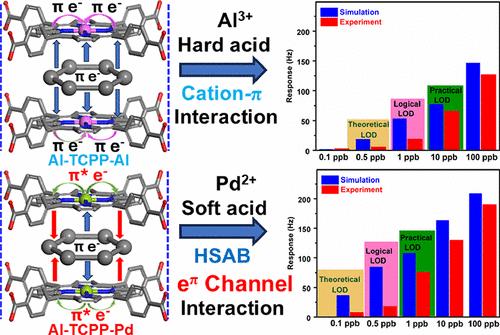将单个Pd原子引入二维金属-有机框架中以增强苯蒸汽检测
IF 9.1
1区 化学
Q1 CHEMISTRY, ANALYTICAL
引用次数: 0
摘要
我们设计和合成了一种二维卟啉金属有机框架(MOF), al - tpp - pd,它包含原子分散的钯位,用于超灵敏的苯蒸汽检测。与原始的Al-TCPP和Al-TCPP- al类似物相比,Al-TCPP- pd表现出优异的性能,实际检出限为1 ppb(逻辑LOD为0.48 ppb),在1 ppm苯浓度下的响应值是Al-TCPP的4倍。这种显著的灵敏度归因于MOF矩形孔内的几何约束和Pd配位诱导的π电子通道增强的协同机制。该传感器对芳香族和非芳香族干扰气体具有优异的选择性,对湿度的抵抗能力强,在180天以上的长期运行稳定性。通过原位拉曼、准原位XPS和大正则蒙特卡罗模拟,揭示了优越的检测性能归因于pd活化孔隙中吸附能的增加和苯的优先定位。这些结果强调了贵金属单原子功能化在提高基于mof的传感器性能方面的有效性,并为设计提供了模块化框架。本文章由计算机程序翻译,如有差异,请以英文原文为准。

Introducing Single Pd Atoms into a Two-Dimensional Metal–Organic Framework for Enhanced Benzene Vapor Detection
We report the design and synthesis of a two-dimensional porphyrinic metal–organic framework (MOF), Al-TCPP-Pd, which incorporates atomically dispersed palladium sites for ultrasensitive benzene vapor detection. Compared with pristine Al-TCPP and Al-TCPP-Al analogs, Al-TCPP-Pd exhibits superior performance with an actual detection limit of 1 ppb (logic LOD is 0.48 ppb) and a response value that is four times higher than Al-TCPP at 1 ppm benzene concentration. This remarkable sensitivity is attributed to a synergistic mechanism involving geometric confinement within the MOF’s rectangular pores and π-electron channel enhancement induced by Pd coordination. The sensor also shows excellent selectivity against aromatic and nonaromatic interfering gases, strong resistance to humidity, and long-term operational stability over 180 days. Through in situ Raman, quasi-in situ XPS, and Grand Canonical Monte Carlo simulations, it is revealed that the superior detection performances are attributed to the increased adsorption energies and preferential benzene localization in Pd-activated pores. These results underscore the effectiveness of noble metal single-atom functionalization in enhancing MOF-based sensor performance and offer a modular framework for designing.
求助全文
通过发布文献求助,成功后即可免费获取论文全文。
去求助
来源期刊

ACS Sensors
Chemical Engineering-Bioengineering
CiteScore
14.50
自引率
3.40%
发文量
372
期刊介绍:
ACS Sensors is a peer-reviewed research journal that focuses on the dissemination of new and original knowledge in the field of sensor science, particularly those that selectively sense chemical or biological species or processes. The journal covers a broad range of topics, including but not limited to biosensors, chemical sensors, gas sensors, intracellular sensors, single molecule sensors, cell chips, and microfluidic devices. It aims to publish articles that address conceptual advances in sensing technology applicable to various types of analytes or application papers that report on the use of existing sensing concepts in new ways or for new analytes.
 求助内容:
求助内容: 应助结果提醒方式:
应助结果提醒方式:


